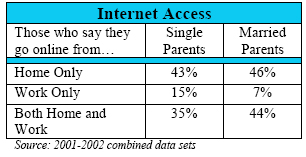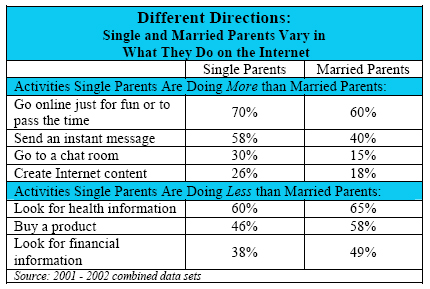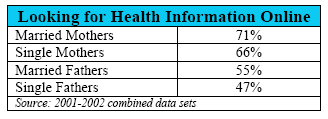Single Parents Lag Behind Married Parents in Computer and Internet Use
Note: All numbers and percentages in this section regarding single parents were derived from combined data from Pew Internet & American Life tracking surveys from 2001 to 2002, unless otherwise noted. Combining data sets was necessary to amass a large enough sample to probe meaningful and statistically relevant differences between single parents and married parents. The combined survey samples contain interviews with 18,017 adults (age 18 and older), of whom 6,161 are parents of children under 18. In that sample, 1,501 are single parents. The interviews were conducted in several surveys taken at various points between February 1, 2001 and May 15, 2002.
The Pew Internet & American Life Project estimates that there are 6.5 million single parents of children 18 and younger in the United States who use the Internet. About 4 million of these are single mothers and 2.5 million are single fathers.

There are significant differences between parents who are single and parents from two-parent households. Single parents are less likely to use a computer or the Internet than are married parents. Some 69% of single parents use computers, compared to 80% of married parents. In addition, 58% of single parents use the Internet, compared with 71% of married parents. This technological divide is most likely attributable to the lower average household income of a single parent family, which makes the price of a computer and monthly Internet service a larger financial burden.
Of the parents who do go online, married parents tend to be the more experienced Internet users. Single parents are twice as likely as married parents to be Internet newbies – those who have gotten online in the past six months. At the other end of the experience scale, 33% of online single parents have been Internet users for more than 3 years, compared to 43% of online married parents have used the Internet for this long.
This difference in technology adoption between single-parent households and two-parent households is also evident when it comes to children’s access to computers and the Internet. Our surveys have found that youth between the ages of 12 and 17 are less likely to be Internet users if they live in a single-parent household. According to our March-May 2002 survey, 62% of single parents with children this age said at least one of their children in this age group goes online. That compares to 73% of married parents said at least one of their children 12 to 17 years old goes online.
Single Fathers Are Frequent Internet Users
Single parents who use the Internet go online with about the same frequency as online married parents: 35% of both groups go online several times a day. Among single online parents, single fathers are more frequent users of the Internet than single mothers, with 40% of single fathers reporting that they use the Internet several times a day. Only 33% of single mothers said they went online this frequently.
Single and married parents differ somewhat in the places where they have Internet access. Married parents are more likely to have Internet access at both work and home. Single parents are twice as likely as married parents to have access only at work.
Single Parents Communicate Online, Married Parents do Research
In our survey of 754 parents and their teenagers in December 2000 we found that children who live in single-parent households were more likely than children in two-parent homes to go online for fun, visit chat rooms, and play or download games online. Children of married parents were more likely than those in single-parent homes to search for news and to buy products online. It might be the case that this difference might indicate that the computer plays the role of a babysitter or companion more often for children of single parents.
This also reflects parental patterns: Single parents are more likely than adults in two-parent homes to go to chat rooms and go online for fun then their married counterparts. This might be linked to the fact that single parents tend to be younger than married parents. It also might reflect the way that some Web sites cater to single parents. For example, many Web sites that advertise themselves as resources for single parents have a readily accessible link to an online dating service and a chat room.

Another difference between the two groups is that single parents are more likely to go online “just for fun or to pass the time” than married parents. Pew Internet surveys from August 2001 through January 2002 indicate that 70% of online single parents go online just for fun, compared to 60% of married parents. And single parents are more likely than married parents to play online games.
On the other hand, married parents with Internet access are more likely to buy products and seek financial information. This financial focus might be partially explained by the higher average household income of married parents. With more money in their budgets, they are more prone to spend and manage it online.
Married parents are slightly more likely than single parents to look for health and medical information online. And, as mentioned earlier, mothers – both single and married – are more likely to look for health information than fathers. Married mothers show the most interest in health Web sites; single fathers show the least.





